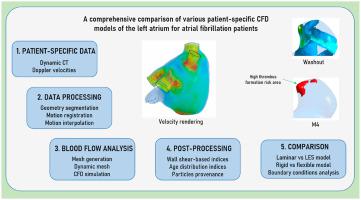Computers in Biology and Medicine ( IF 7.7 ) Pub Date : 2021-04-24 , DOI: 10.1016/j.compbiomed.2021.104423 Jorge Dueñas-Pamplona 1 , Javier García García 1 , José Sierra-Pallares 2 , Conrado Ferrera 3 , Rafael Agujetas 3 , José Ramón López-Mínguez 4

|
Background
Recently, advances in medical imaging, segmentation techniques, and high-performance computing have supported the use of patient-specific computational fluid dynamics (CFD) simulations. At present, CFD-compatible atrium geometries can be easily reconstructed from atrium images, providing important insight into the atrial fibrillation (AF) phenomenon, and assistance during therapy selection and surgical procedures. However, the hypothesis assumed for such CFD models should be adequately validated.
Aim
This work aims to perform an extensive study of the different hypotheses that are commonly assumed when performing atrial simulations for AF patients, as well as to evaluate and compare the range of indices that are usually applied to assess thrombus formation within the left atrium appendage (LAA).
Methods
The atrial geometries of two AF patients have been segmented. The resulting geometries have been registered and interpolated to construct a dynamic mesh, which has been employed to compare the rigid and flexible models. Two families of hemodynamic indices have been calculated and compared: wall shear-based and blood age distribution-based.
Results
The findings of this study illustrate the importance of validating the rigid atrium hypothesis when utilizing an AF CFD model. In particular, the absence of the A-wave contraction does not avoid a certain degree of passive atrial contraction, making the rigid model a poor approximation in some cases. Moreover, a new thrombosis predicting index has been proposed, i.e., M4, which has been shown to predict stasis more effectively than other indicators.
中文翻译:

房颤患者左心房各种特定于患者的CFD模型的综合比较
背景
最近,医学成像,分割技术和高性能计算的进步已经支持使用特定于患者的计算流体动力学(CFD)模拟。目前,可以轻松地从心房图像重建与CFD兼容的心房几何形状,从而提供对房颤(AF)现象的重要见解,并在治疗选择和外科手术过程中提供帮助。但是,对于这种CFD模型假设的假设应得到充分验证。
目标
这项工作旨在对房颤患者进行心房模拟时通常假设的不同假设进行广泛研究,以及评估和比较通常用于评估左心耳附件(LAA)内血栓形成的指标范围)。
方法
两名房颤患者的房型已被分割。生成的几何形状已被记录和插值以构造动态网格,该网格已用于比较刚性模型和柔性模型。已经计算并比较了两个家族的血液动力学指标:基于壁剪切和基于血年龄分布。
结果
这项研究的结果说明了在使用AF CFD模型时验证刚性心房假说的重要性。特别是,没有A波收缩不能避免一定程度的被动心房收缩,因此在某些情况下,刚性模型的近似性很差。而且,已经提出了一种新的血栓形成预测指标,即M4,它已被证明比其他指标更有效地预测血瘀。

























 京公网安备 11010802027423号
京公网安备 11010802027423号